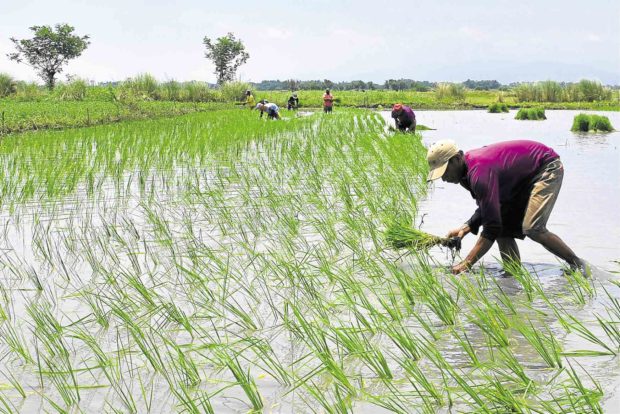Irrigation improves Pangasinan rice yield amid drought

NO RAIN, NO PROBLEM Rice farmers in Villasis, Pangasinan province, are assured of good harvest amid the dry spell as water supply from San Roque Dam and local rivers and creeks is enough to irrigate paddies in the province. —WILLIE LOMIBAO
LINGAYEN, Pangasinan — While other drought-hit provinces grapple with severe crop damages, farmers in Pangasinan province enjoy good harvests this rice planting season.
“Farmers in about 80 percent of the province’s irrigated areas have harvested so far, and by the end of April, everybody shall have harvested their crop,” Nestor Batalla, assistant provincial agriculturist, said on Monday.
Cropping schedule
The province has 87,000 hectares of irrigated rice land, with 40,000 ha drawing water from San Roque Dam in San Manuel town. The rest use communal irrigation systems.
Batalla said the average rice yield per hectare was 4.6 metric tons during this cropping season. Dry season planting runs from October to March while the wet season is from April to September.
Article continues after this advertisementAccording to Batalla, losses were avoided because farmers followed the cropping schedule.
Article continues after this advertisementAt a recent interagency meeting, rice farmers agreed to take turns in getting irrigation water for their rice land at the start of the planting season.
This will allow farmers to time their rice planting when there is already available water, Batalla said, adding that without San Roque Dam, the water situation would be different.
Rivers, creeks
Tom Valdez, San Roque Power Corp. vice president for corporate social responsibility, said the dam’s operation was based on irrigation requirements.
“We don’t generate power more than what is required by irrigation,” Valdez said, adding that the dam has still enough water in its reservoir for irrigation.
At 6 p.m. on April 1, the dam’s water elevation was 259.33 meters above sea level (masl), 20.67 meters below its high normal level of 280 masl.
In the communal irrigation systems, water comes from creeks, rivers and underground, Batalla said. But aquifers had sunk deeper in some areas, making it difficult for farmers to pump out water, he said.
He said the provincial government had been helping farmers by lending to them its drilling machines to reach deeper the water tables.
Pangasinan produces at least 1.3 million MT of rice every year, making it the country’s third rice-producing province.
Cloud seeding in Cordillera
In Cordillera, officials have asked that cloud seeding operations be conducted in Ifugao, Apayao and Kalinga provinces.
The Cordillera Regional Disaster Risk Reduction and Management Office also ordered an inventory of irrigation facilities in the region as officials assessed the impact of the mild El Niño phenomenon that may last until May.
Close to 18,000 farmers and about 11,000 ha of farmlands, most of them planted to corn, have been affected by the dry spell in Cordillera.
Farmers in Apayao said they expected rain in February and March to make up for the drought. Apayao’s crop losses amounted to P456 million.
On March 18, the Paracelis council in Mountain Province placed the town under a state of calamity due to the drought. —Reports from Gabriel Cardinoza and Vincent Cabreza